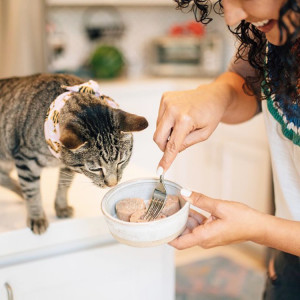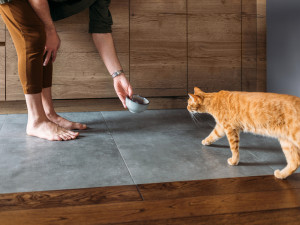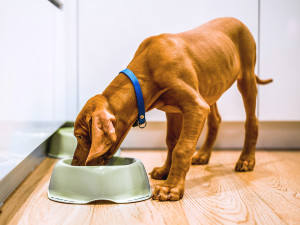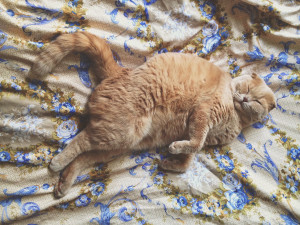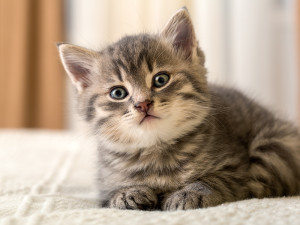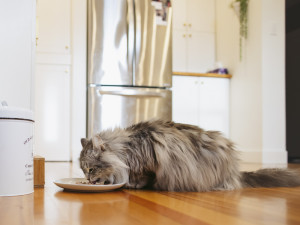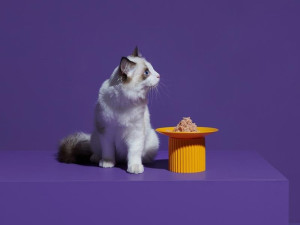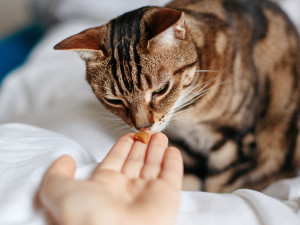The Ultimate Puzzle: Picking the Right Cat Food
Four veterinary nutritionists pick apart the claims so that you can choose the right food for your kitty.
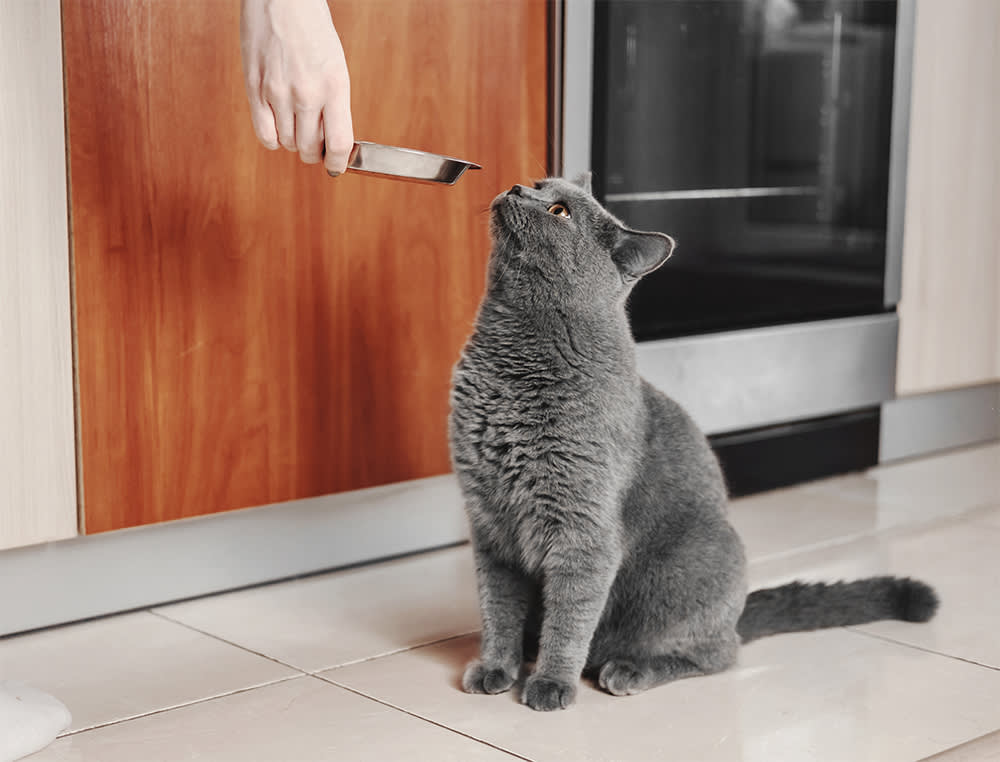
Share Article
Cats are notoriously fussy when it comes to their food. (If we had a dollar for every time ours flicked its tail at a new bowl of kibble, we’d be in the moneyopens in new tab.) Finicky taste aside, the cat food options out there can be overwhelming for pet parents: Canned. Raw. Freeze-dried. Grain-free. High protein. Sensitive stomach… the list goes on.
But don’t stress. Kinship asked a panel of four veterinary nutritionists for their expert advice on choosing a cat food that will satisfy your pet’s appetite (and your desire to keep your kitty healthy).
Look for the AAFCO label.
“Standing in the pet store, reading labels, is fraught with frustration,” admits Dr. Julie A. Churchill, a professor of veterinary nutrition at the University of Minnesota. But resist the temptation to choose the cat food with the cutest kitten on the bag. Instead, focus on the fine print: Check for the “AAFCO” label. Foods with the AAFCO seal meet strict guidelines for nutrient contents.
“It offers a level of confidence that you’re choosing a complete and balanced diet for your feline friend,” adds Dr. Korinn Saker, professor of clinical nutrition at North Carolina State University. “Read the ingredient label, too — there are diets that have labels with 30 to 50 ingredients. The fewer ingredients in a diet, the easier it’ll be for your cat to digest the food and absorb the nutrients.”

Consider your cat’s life stage.
“Although cats need protein, fat, and carbohydrates throughout their lives, the quantities they require change based on their life stage,” says Dr. Lindsey Bullen, board-certified veterinary nutritionist at BluePearl Pet Hospital. It’s important to feed kittens food that’s age-appropriate so the little creatures get all of the right nutrients, in the right amounts, for healthy growth and development — until they’re about one year old.
“When cats are spayed or neutered, regardless of their age, their metabolic rate (the number of calories they require) goes down 25 to 30 percent,” Dr. Churchill says. So, continuing to feed your altered cat kitten food, even if they’re still little, could cause them to pack on the pounds and put them at high risk for health conditions associated with being overweight (60 percent of cats are overweight).
When your kitten has reached a healthy weight, you can switch to an adult maintenance cat food. (You could also switch to a senior diet when their whiskers start to turn grey at around age 11, but it’s not essential.) “When we look at the nutrient analyses, there are no significant differences between adult and senior cat food diets,” says Dr. Jonathan Stockman, an assistant professor of veterinary nutrition at Long Island University.
Select a style
Kibble or canned cat food
“While some cats have a preference for wet or dry food, as long as the brand you choose provides complete and balanced nutrition for your cat’s life stage, the decision to stock up on tins of wet cat food or scoop dry kibble from the bag is a matter of your cat’s palate,” Dr. Saker says.
Raw, dehydrated, or freeze-dried cat food
The decision to feed raw, dehydrated, or freeze-dried cat food is a little more complex. “Some pet parents want to feed their cats like their wild counterparts,” Dr. Bullen says. “And wild cats eat raw food.” Indeed, cats are obligate carnivores who thrive on high-protein cat food. These “biologically appropriate” diets are formulated to mirror a cat’s ancestral diet with 98 percent meat, organs, and bone.
They are digested more efficiently and — while there is some controversy about raw feeding — pet parents who feed their felines raw cat food have seen numerous health benefits: shinier coats, cleaner teeth, ideal weight, and less allergies. Not to mention, you’d be hard-pressed to find a more palatable meal for a cat than raw meat.
No need to head to the butcher for a bloody slab of steak. Raw- and freeze-dried cat food brands should not only offer complete and balanced nutrition for all life stages (check the label). But it can also be packaged with pet parents in mind: frozen raw “nuggets” can be defrosted overnight, while freeze-dried cat food can be kept in the pantry and rehydrated with warm water at mealtime. Skeptics of such diets cite concerns of bacteria such as E. coli or salmonella, but cats’ digestive systems are pretty hardy, plus the risk is greatly reduced when opting for freeze-dried over raw cat food.
Consider the claims.
High-protein cat food
Just as you would for yourself at the grocery store, exercise a little skepticism when selecting your cat’s meals: “High-protein” cat food might actually have the same amount of protein as other varieties. “Protein isn’t necessarily a ‘more is better’ ingredient,” Dr. Stockman says. “If your cat food meets the protein requirements for a complete and balanced diet, there isn’t really a benefit to adding more.”
High-fiber cat food
On the other hand, “high-fiber” cat food might in fact contain more fiber than other options on the shelf, which could alleviate constipation and help hairballs pass more easily through the digestive tract. Dr. Stockman adds, “It could also mean looser stools and more time in the litterbox.”
Grain-free cat food
Grain-free cat food is as much a trend in their world as it is in ours. In these popular diets, common grains, such as corn, rice, and wheat are replaced with other carbohydrates such as lentils, sweet potatoes, or tapioca. It’s important to consider the research around this type of food and discuss any risks with your vet.
Remember, grain free doesn’t mean low carb — it’s simply an exchange of carbohydrates. While cats will choose mice over rice any day, “grain allergies are extraordinarily rare in cats,” Dr. Churchill says. “Consumers ascribe a health benefit to grain-free diets but there are no proven health benefits.” That said, cats with cancer should avoid carbohydrates altogether, as cancer cells are known to thrive on them.
Talk to your vet.
If you’re struggling to choose the right food because of a health problem with your cat, make an appointment with your veterinarian. Even though there are foods that promise to solve for everything from urinary tract infections to sensitive stomachs to immune support, it’s important to rule out underlying health conditions first.
An accurate diagnosis might be key to getting the right food for your cat. For example, diabetic cats can benefit from a prescription diabetic diet that contains the right balance of nutrients to keep their blood sugar levels in check. Per Dr. Bullen, “These diets are often higher in protein and lower in carbohydrates, which provides a slow, sustained release of glucose rather than a sharp peak after eating excess carbs.” At the end of the day, “nutrition is the cornerstone of health,” Dr. Churchill adds. “Great nutrition can take an animal from surviving to thriving.”
Disclaimer alert: This article is here to share information. But, much like pineapple on pizza, the topic may be controversial. Meaning, not all vets or pet professionals agree. Because every pet is a unique weirdo with specific needs. So, don’t take this as fact or medical advice. Talk things over with your vet when making decisions, and use your best judgment (about both your pet’s health and pizza toppings).

Jodi Helmer
Jodi Helmer is a North Carolina-based freelance writer who shares her home with an embarrassing number of rescue dogs and relies on four feral cats to patrol the barn. When she isn’t refilling food and water dishes, Jodi writes about animals for Scientific American, Sierra, WebMD, AKC Family Dog, Living the Country Life, and Out Here.
Related articles
![brown puppy eating food out of green bowl]()
A Digestible Guide to Healthy Dog Food for Your New Pup
How to pick the right grub for your dog when there are So. Many. Choices.
![overweight orange cat]()
How Much Should You Actually Be Feeding Your Cat?
If they’ve lost their hourglass figure, then not that much — according to a veterinary nutritionist.
![Kitten sitting on a blanket]()
7 Steps to Keep Your New Kitten Happy and Healthy
With great cuteness comes great responsibility. A vet breaks down everything you need to know when you bring home a new kitten.
![A cat eating wet food from a dish in the kitchen.]()
8 Cat Meal Toppers for Finicky Eaters
Tips for improving your cat’s appetite with these tasty add-ons.
![White and brown cat on deep purple background next to yellow modern cat bowl]()
Stylish Cat Bowls Almost Too Pretty to Eat Off Of
Whisker-friendly dishes, modern elevated feeders, hand-painted porcelain, and more.
![cat being offered a treat or vitamin]()
The Best Supplements and Vitamins for Cat Health
Not your mama’s multivitamin.



